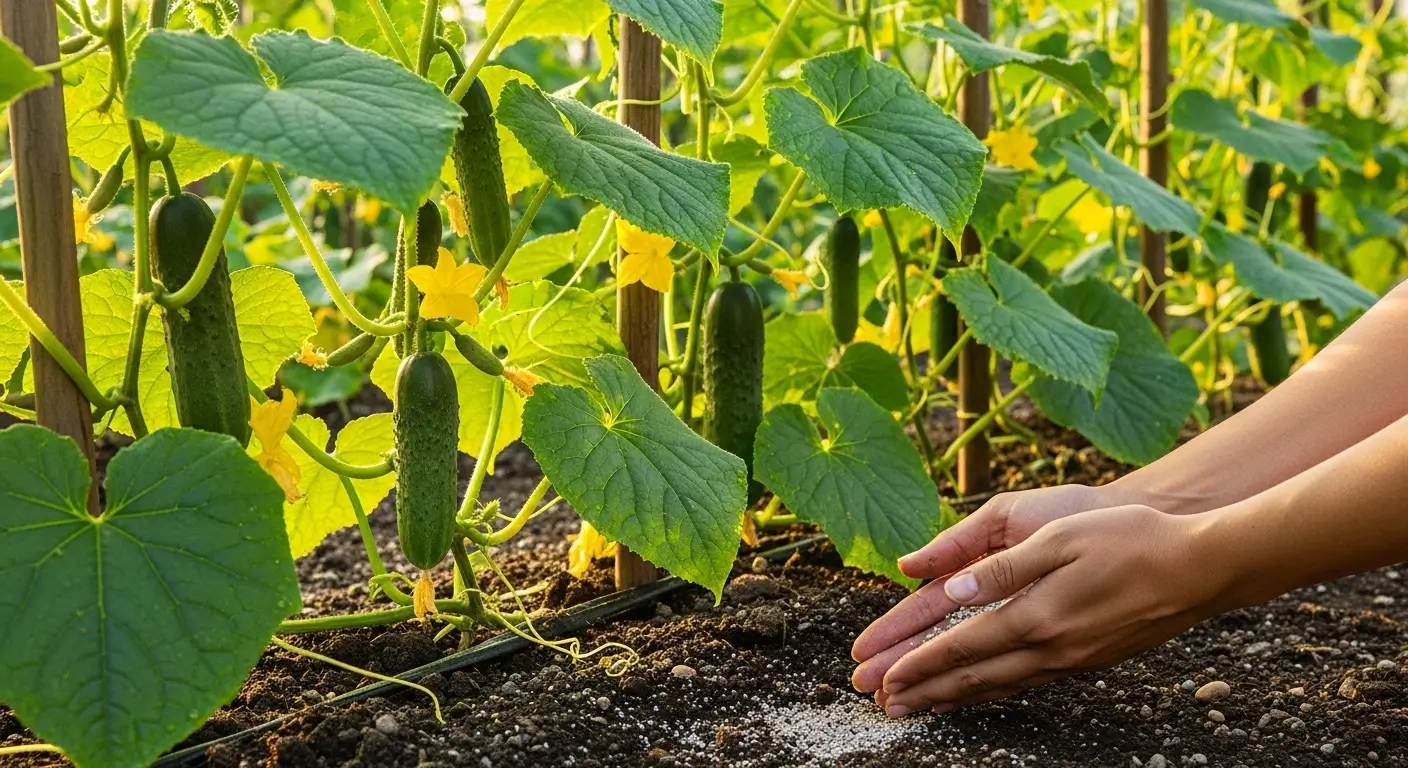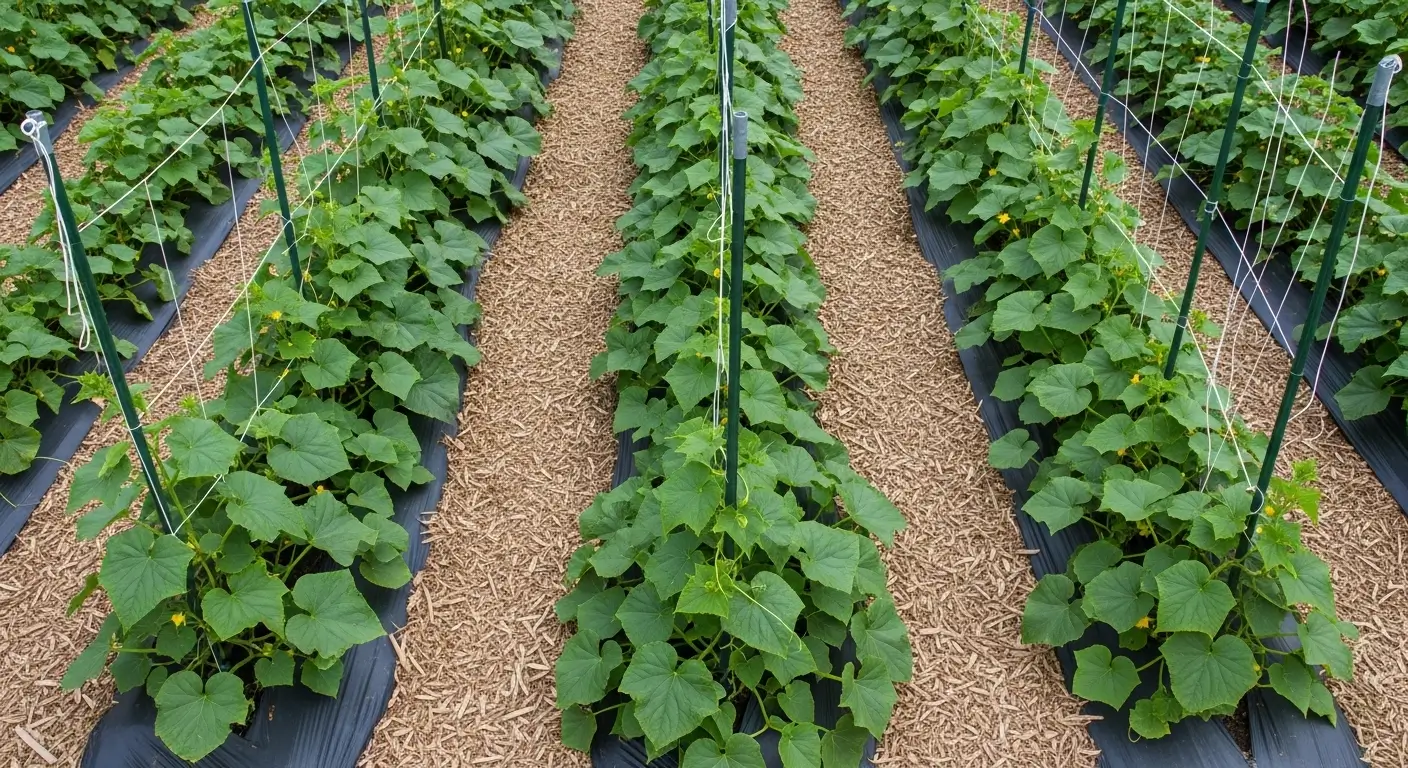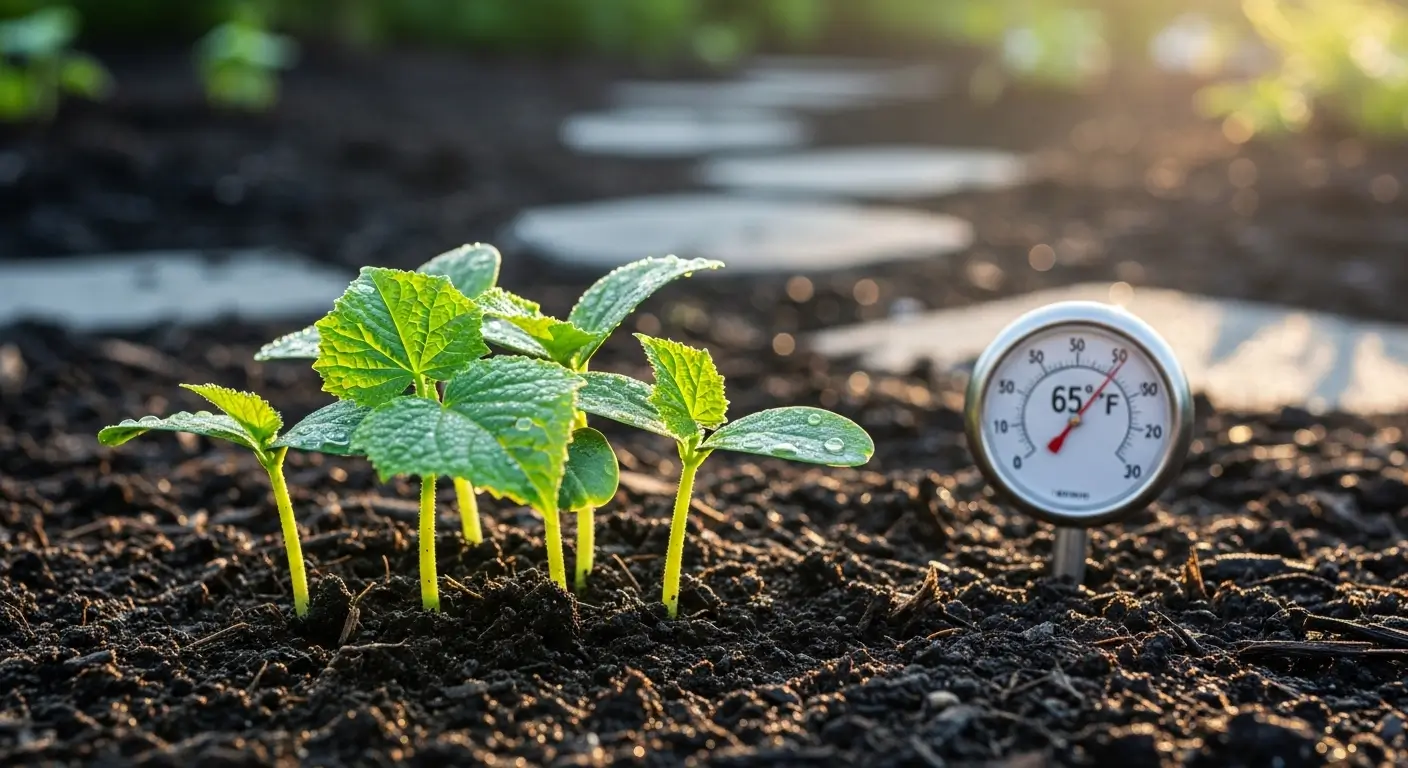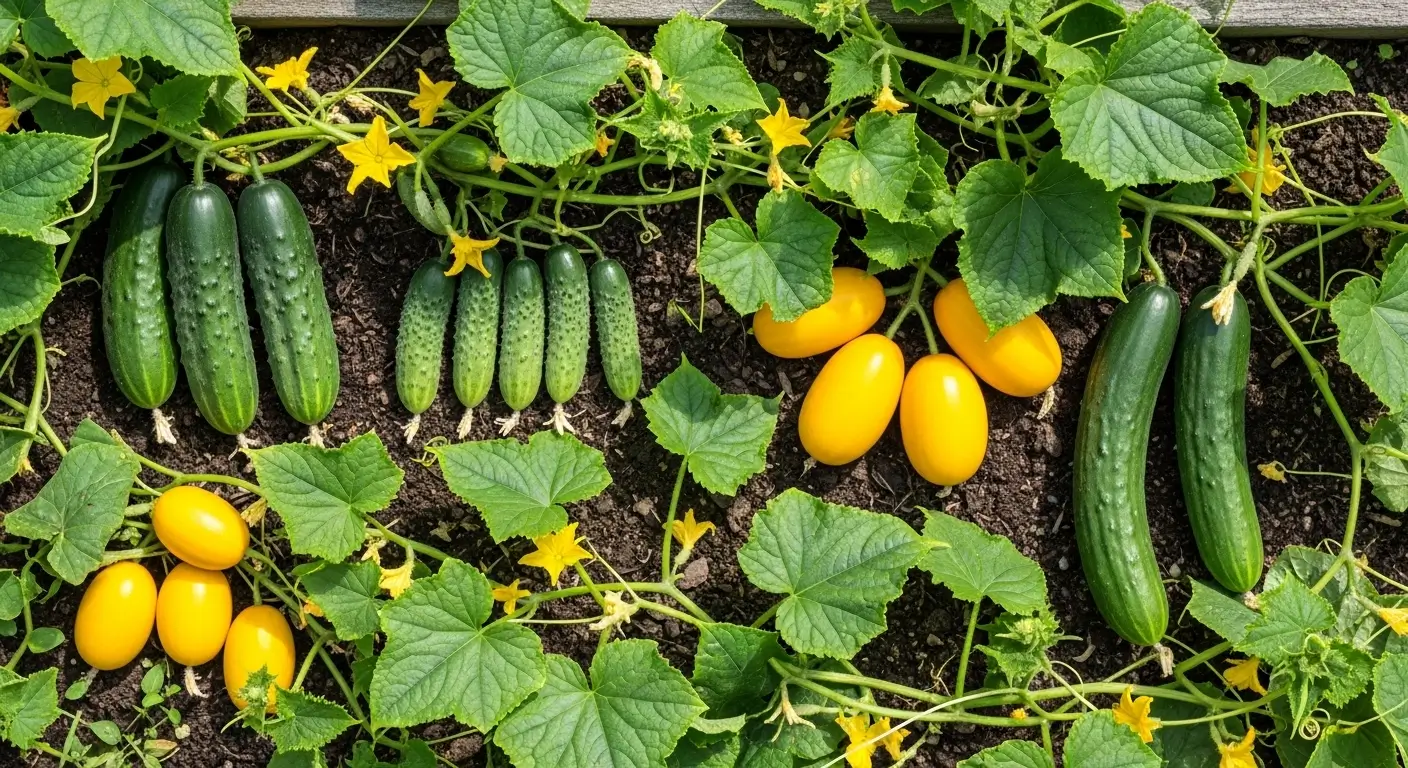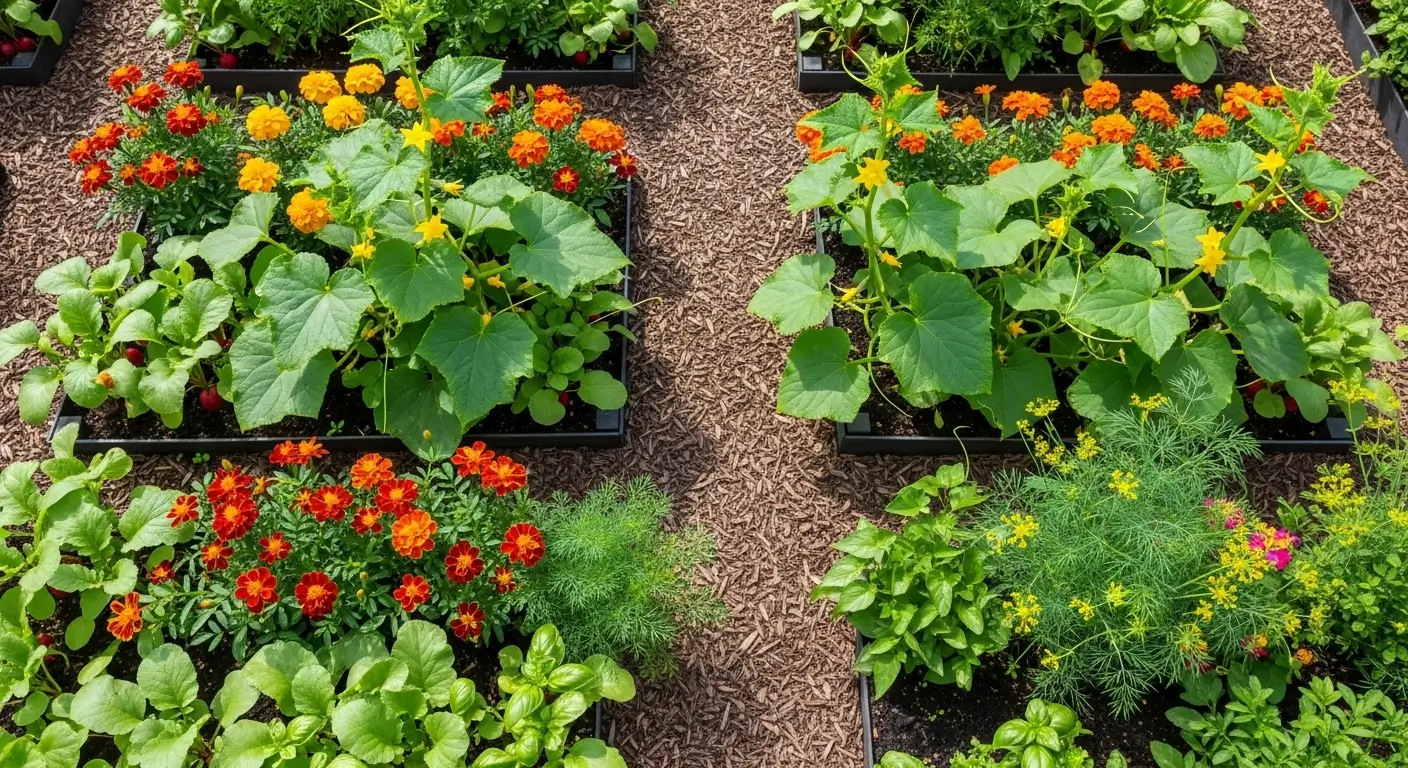Okay, real talk – have you ever looked at your cucumber plants and thought “Why aren’t you giving me ALL the cucumbers?!” Because I sure have. Last year, I had these absolutely gorgeous vines that took over half my garden. I’m talking magazine-worthy greenery everywhere. But when it came time to harvest? Pathetic little cucumbers that looked more like sad pickles than the beautiful cukes I was dreaming of.
That’s when it hit me – I’d been basically starving my plants while admiring how pretty they looked. Whoops! Turns out cucumber fertilization isn’t just some fancy gardening term you can ignore. These plants are basically bottomless pits regarding nutrients, and once I figured that out, everything changed.
So grab a coffee (or a beer – no judgment here), and let me tell you everything I wish I’d known about feeding these hungry, hungry vines.
Table of Contents
Understanding Cucumber Fertilization: Your Plant’s Nutritional Needs
Cucumbers are the teenagers of the vegetable garden. They’re growing like crazy, always hungry, and eating you out of house and home if you let them. Instead of raiding your fridge, they’re constantly pulling nutrients from your soil.
These plants are what gardeners call “heavy feeders” – a fancy way of saying they’re nutrient hogs. While your lettuce is politely sipping nutrients like it’s having afternoon tea, your cucumbers are chugging them like they’re at a frat party.
Here’s what they’re constantly demanding: nitrogen for all those big, beautiful leaves, phosphorus so they can actually make flowers (and then cucumbers!), and potassium to keep the fruit quality good and fight off diseases. University research confirms that proper NPK balance is crucial for cucumber production. It’s like they need a balanced diet, just like us.
But here’s the kicker – their appetite changes throughout the season. Early on, they’re all about that nitrogen because they’re trying to build their vine empire. But once those little yellow flowers start showing up? They shift gears and want more phosphorus and potassium for baby-making. Think of it like feeding a growing kid – their needs change as they get older.
The trick is learning to read the signs when they’re hangry. Yellow leaves, weird-shaped cucumbers, or barely any fruit at all? Yeah, they’re probably trying to tell you something.
The Best Fertilizer for Cucumbers: Finding Your Perfect Match
Let’s get into the good stuff – what to feed these demanding little divas. And I’m gonna be honest, there’s no one “perfect” fertilizer. It’s like asking what the best pizza topping is – it depends on your taste, your budget, and what you’ve got available.
Organic Options That Actually Work
I’m totally team organic, and here’s why – organic fertilizers are like that friend who brings you soup when you’re sick and also does your dishes. They don’t just feed your plants; they make your whole soil ecosystem healthier.
My absolute favorite? Good old-fashioned compost. I know – everyone talks about compost like it’s some miracle cure. But honestly? It is. I dump about 2-3 inches of the good stuff on my cucumber beds every spring, and it’s like giving them a multivitamin that lasts all season.
Fish emulsion is another winner, especially early in the season when they need that nitrogen boost. Fair warning, though – it smells like… well, like dead fish. Your neighbors might give you weird looks for a day or two, but your cucumbers will be doing happy dances.
And worm castings? Pure cucumber gold. I call it “plant candy” because I’ve never met a cucumber that didn’t perk up after getting some. Plus, you can’t overdo it, which is perfect for people like me who sometimes get a little fertilizer-happy.
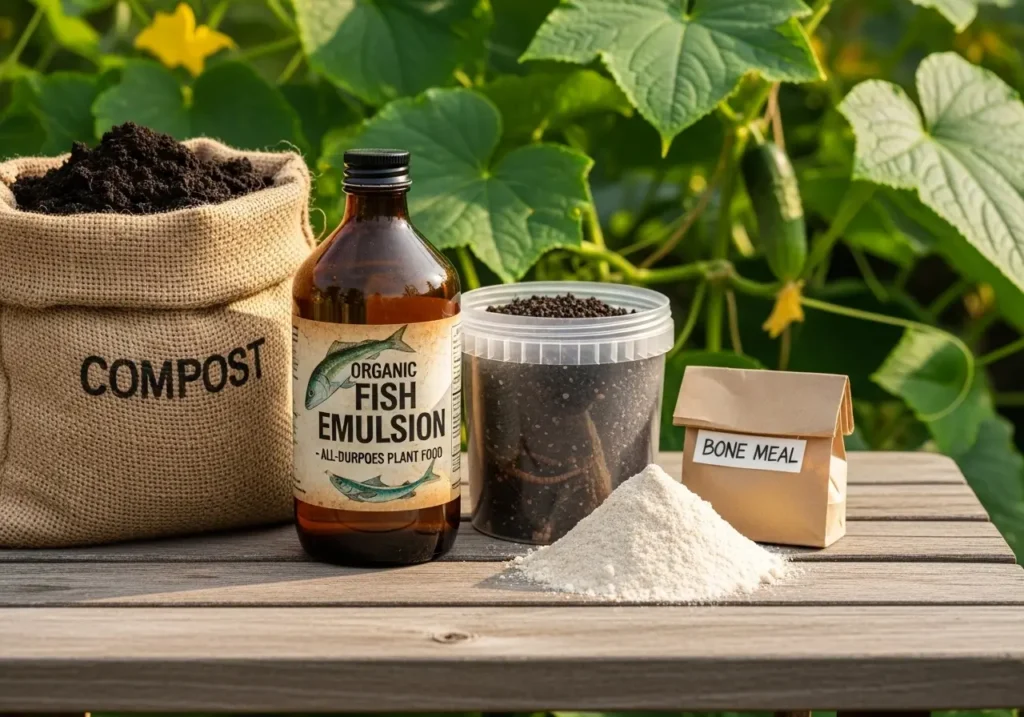
Synthetic Fertilizers: The Quick Fix
Look, I’m not gonna shame anyone for using synthetic fertilizers. Sometimes you need results fast, and synthetic is like the espresso shot of the fertilizer world. A basic 10-10-10 works great, though I try to dial back the nitrogen once flowering starts (more on that later).
The thing with synthetic food is that it’s like fast food – it’ll fill you up quickly, but it’s not doing much for your long-term health. If you go this route, still throw some compost around to keep your soil happy.
The Fancy Stuff
Some companies make fertilizers specifically for cucumbers and vine crops. These are usually well-balanced for what cucumbers want, which removes the guesswork. They cost more, but if you’re the type who likes things spelt out for you, they’re worth it.
🌱 Fertilizer Quick Comparison Tool
Click to compare different fertilizer types for your cucumbers:
✅ Pros
- Improves soil health long-term
- Slow, steady nutrition
- Less risk of burning plants
- Feeds beneficial soil microbes
- Environmentally friendly
❌ Cons
- More expensive upfront
- Works slowly
- Can smell funky (fish emulsion)
- May need more frequent applications
✅ Pros
- Fast results
- Precise nutrient control
- Less expensive initially
- Easy to apply
- Widely available
❌ Cons
- Can burn plants if over-applied
- Doesn’t improve soil structure
- Needs frequent reapplication
- Can leach away quickly
✅ Pros
- Quick absorption
- Easy to mix and apply
- Great for foliar feeding
- Works well with drip systems
- Even distribution
❌ Cons
- Needs frequent application
- Can wash away with rain
- More labor intensive
- Short-term nutrition
✅ Pros
- Long-lasting nutrition
- Easy to store and handle
- Less frequent applications
- Works with rain irrigation
- Great for side-dressing
❌ Cons
- Slower to take effect
- Uneven distribution possible
- Needs water to activate
- Can burn if touching stems
Look, I know choosing between all these options can feel overwhelming – trust me, I stood in the garden center for like 20 minutes last spring trying to decide! That’s exactly why I put together this little comparison tool above. It breaks down the real pros and cons of each type so you can pick what works for your situation and budget.
The truth is, I’ve had great success with all of these fertilizer types over the years. What matters most is consistency and understanding what your plants need when. Now let’s talk about that timing piece.
When to Fertilize Cucumbers: Timing is Everything
This is where I used to mess up big time. I thought fertilizing was like watering – just do it whenever you remember and hope for the best. Wrong! Timing matters way more than I ever imagined.
Before You Even Plant
I start my fertilization game plan before my cucumbers go in the ground. About two weeks before planting, I work compost and slow-release fertilizer into the soil. It’s like meal prep, but for plants.
Trust me on this – if you skip this step and try to fix bad soil later, you’ll be playing catch-up all season. Been there, done that, got the disappointing cucumber harvest to prove it.
Baby Plant Phase (Weeks 1-4)
Once my little seedlings are settled in (usually about a week after I transplant them), I start the nitrogen party. This is when they’re putting all their energy into getting big and leafy. I hit them with fish emulsion or high-nitrogen organic stuff every 10-14 days.
Think of it like feeding a growing teenager – they need lots of everything to fuel that growth spurt.
Flower Power Time (Week 5 and Beyond)
Here’s where things get interesting. I completely changed my game plan when I saw those little yellow flowers. Too much nitrogen backfires at this point – you’ll get gorgeous plants with practically no cucumbers.
I learned this the hard way one year when I had the most beautiful cucumber vines in the neighborhood and about six actual cucumbers to show for it. My neighbor’s scraggly-looking plants were outproducing mine 10 to 1. Humbling moment right there.
Once flowering starts, I switch to balanced fertilizer or something with more phosphorus and potassium. This helps with flower production and actually makes those cucumbers we’re all here for.
The Long Haul
Cucumbers keep producing until frost kills them, which means they need steady feeding all season long. I fertilize every 2-3 weeks during peak season and watch the plants. If they look happy, I might stretch it a bit longer. If they look stressed, I might bump it up.
Organic vs. Synthetic: The Great Debate
Okay, let’s settle this once and for all – both work. I’ve grown excellent cucumbers with both organic and synthetic fertilizers. The choice comes down to your style and what you’re trying to achieve.
Why I’m Team Organic
Here’s the thing about organic fertilizers – they’re playing the long game. They don’t just feed your plants; they’re building better soil, encouraging beneficial bugs and microbes, and generally making your garden ecosystem healthier.
The downside? They’re usually more expensive upfront and take longer to work. If you’ve got seriously messed-up soil, you might need to supplement with synthetic to get things moving.
When Synthetic Makes Sense
There are definitely times when I reach for the synthetic stuff. Container growing? Synthetic is often easier. Severe nutrient deficiency that needs fixing NOW? Synthetic to the rescue.
The key is not relying on it exclusively. I always make sure to add organic matter even when using synthetic fertilizers, because healthy soil is the foundation of everything.
Application Methods That Actually Work
Here’s something nobody tells you when you start gardening – HOW you put fertilizer down matters almost as much as WHAT fertilizer you use. I wish someone had clued me in on this earlier.
Side-Dressing (My Personal Favorite)
This is my go-to method for established plants. I make a little trench about 4-6 inches away from the base of the plant, dump in the fertilizer, and cover it back up. It’s like serving dinner directly to the roots without bothering the main stem.
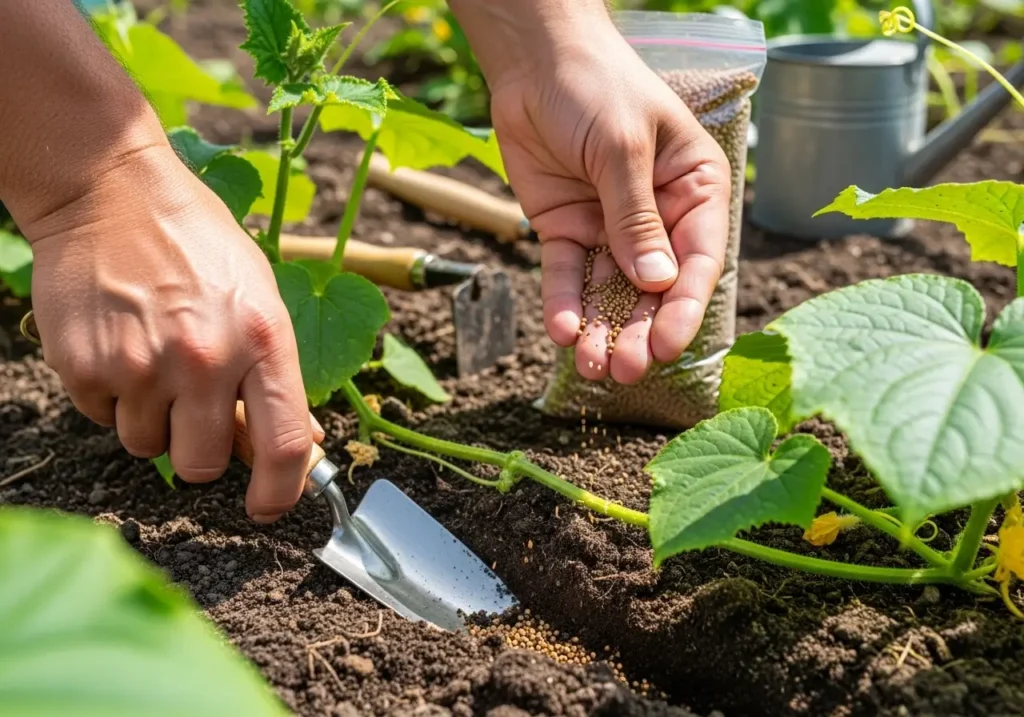
Foliar Feeding for Quick Fixes
When I need to fix a problem fast, I spray fertilizer right on the leaves. Mix it at half-strength and do it early morning or evening – never in full sun unless you want to cook your plants. Found that out the hard way, too.
Drip System Integration
You can inject fertilizer into the water if you’ve got drip irrigation. It’s pretty slick and keeps everything consistent. The plants love the constant, gentle feeding.
Common Cucumber Fertilization Mistakes (Learn from My Failures!)
Oh boy, have I made some spectacular mistakes over the years. Let me share the highlights so you can skip the learning curve.
Mistake #1: The Nitrogen Overdose
For years, I thought more nitrogen = bigger plants = more cucumbers. Nope! I got these absolutely gorgeous, lush plants that looked like they belonged in a magazine, but produced almost no fruit. It was like having a sports car with no gas – pretty but useless.
Mistake #2: The Inconsistent Feeding Syndrome
One year, I was super on top of fertilizing early in the season. Life got busy, and I basically ignored them during flowering. The plants started strong but completely fizzled when they should have been cranking out cucumbers. Consistency wins every time.
Mistake #3: Ignoring pH Like It Doesn’t Matter
I spent forever wondering why my fertilizer wasn’t working, only to find out my soil pH was way off. Cucumbers like slightly alkaline soil (around 6.0-7.0), and if your pH is wrong, they can’t access nutrients, no matter how much you throw at them.
Mistake #4: Container Plant Confusion
Container cucumbers need way more frequent feeding because nutrients wash out every time you water. I treated my container plants the same as my garden ones and wondered why they looked so sad. Live and learn!
Troubleshooting Nutrient Problems
After years of growing these things, I’ve gotten good at reading the signs when something’s wrong. Here’s what to watch for:
Nitrogen Issues
Bottom leaves turning yellow and working their way up? Classic nitrogen deficiency. Hit them with some fish emulsion or other nitrogen-rich fertilizer, and they’ll perk right up.
Phosphorus Problems
Purple or reddish leaves, especially on the undersides? Usually, phosphorus deficiency is more common in cool weather. Bone meal helps, but it’s slow. Rock phosphate is another option.
Potassium Trouble
Brown, crispy leaf edges usually scream, “I need potassium!” This can mess with fruit quality, too. Kelp meal is excellent for this, or wood ash if your soil isn’t already too alkaline.
Magnesium Drama
Yellow between the leaf veins while the veins stay green? That’s magnesium deficiency. Epsom salt dissolved in water is a quick fix, but adding compost long-term is better.
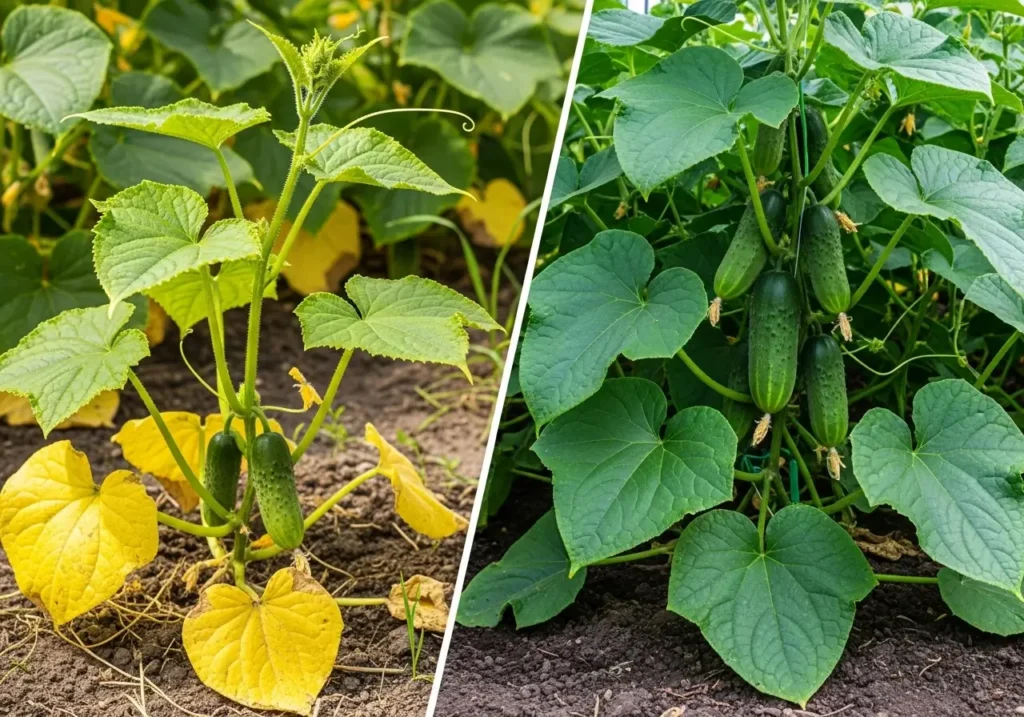
My Seasonal Fertilization Schedule
Here’s what I do in my Zone 5b garden – adjust for your area:
Early Spring: Get beds ready with compost and slow-release organic fertilizer about 4-6 weeks before the last frost.
Late Spring: Start the nitrogen feeding program about 2 weeks after transplanting.
Early Summer: Switch to balanced feeding when flowers show up.
All Summer Long: Keep up with balanced fertilization every 2-3 weeks until harvest is done.
Fall: Add compost to beds after harvest to prep for next year.
Key Things to Remember
After all these years of trial and error (mostly error at first), here’s what really matters:
- Good soil is everything – you can’t fertilize your way out of crappy soil
- Match the food to the growth stage – nitrogen early, balanced later
- Consistent beats perfect – regular, moderate feeding wins over sporadic heavy doses
- Your plants will tell you what they need – learn to read the signs
- Don’t skip the organic stuff – even if you use synthetic, add compost anyway
Look, growing great cucumbers isn’t rocket science, but it does take paying attention. Every garden’s different, so what works perfectly for me might need tweaking for your situation. Don’t be afraid to experiment and see what works.
Check out my complete cucumber growing guide for the full scoop on cucumber growing. And if you’re wondering about timing, I’ve got all the details in my cucumber growing timeline article. Haven’t prepped your soil yet? My soil preparation guide will get you sorted.
What’s your biggest cucumber challenge? I’d love to hear your war stories – the wins, the epic fails, everything in between. Please drop me a comment and let’s figure it out together. The best gardening advice always comes from sharing our mistakes and victories with each other. Happy growing, and may your cucumber harvest be ridiculously abundant!
Cucumber Fertilization Frequently Asked Questions
What is the best fertilizer for cucumbers?
Honestly, there’s no single “best” fertilizer – it depends on your style and soil. I’m a huge fan of organic options like compost and fish emulsion because they feed both your plants and soil long-term. But if you need quick results or have nutrient-deficient soil, a balanced 10-10-10 synthetic fertilizer works great too. The key is consistency, not perfection!
When should I fertilize my cucumber plants?
Think of it like feeding a growing teenager – their appetite changes! Start by prepping your soil with compost before planting. Once your seedlings are settled (about a week after transplanting), hit them with nitrogen-rich fertilizer every 10-14 days. When those first yellow flowers show up, switch to balanced fertilizer every 2-3 weeks. Trust me, timing matters way more than I ever thought when I started gardening.
How often should I fertilize cucumber plants?
This was one of my biggest mistakes early on – being inconsistent! During the first month, I fertilize every 10-14 days with nitrogen-rich stuff. Once flowering starts, I switch to every 2-3 weeks with balanced fertilizer. Container cucumbers are hungrier though – they need feeding more often since nutrients wash out with watering. Watch your plants – they’ll tell you if they’re happy or not.
Can I over-fertilize my cucumber plants?
yes! I learned this the hard way when I thought more nitrogen meant more cucumbers. What I got were these gorgeous, magazine-worthy plants with practically no fruit. Too much nitrogen during flowering actually stops cucumber production. Stick to the schedule, watch for signs like overly lush leaves with no flowers, and remember – your cucumbers want balanced nutrition, not a nitrogen overdose.
